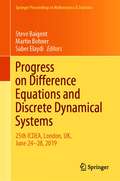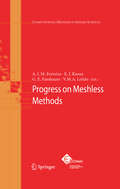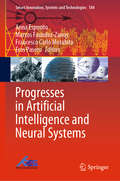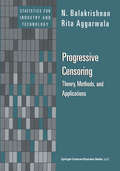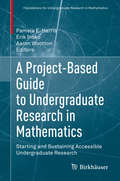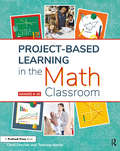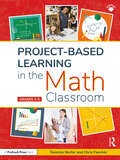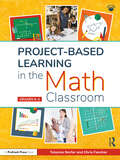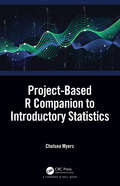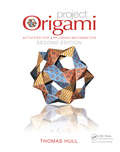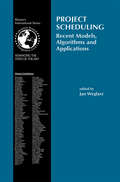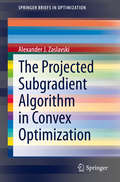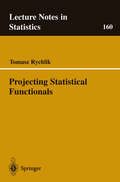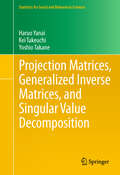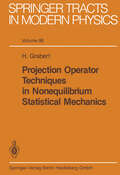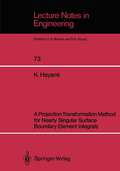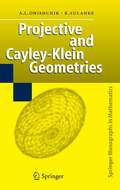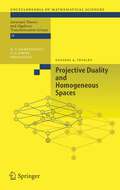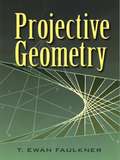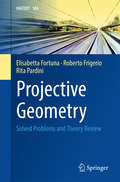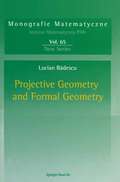- Table View
- List View
Progress on Difference Equations and Discrete Dynamical Systems: 25th ICDEA, London, UK, June 24–28, 2019 (Springer Proceedings in Mathematics & Statistics #341)
by Steve Baigent Martin Bohner Saber ElaydiThis book comprises selected papers of the 25th International Conference on Difference Equations and Applications, ICDEA 2019, held at UCL, London, UK, in June 2019. The volume details the latest research on difference equations and discrete dynamical systems, and their application to areas such as biology, economics, and the social sciences. Some chapters have a tutorial style and cover the history and more recent developments for a particular topic, such as chaos, bifurcation theory, monotone dynamics, and global stability. Other chapters cover the latest personal research contributions of the author(s) in their particular area of expertise and range from the more technical articles on abstract systems to those that discuss the application of difference equations to real-world problems. The book is of interest to both Ph.D. students and researchers alike who wish to keep abreast of the latest developments in difference equations and discrete dynamical systems.
Progress on Meshless Methods (Computational Methods in Applied Sciences #11)
by A. J. M. Ferreira G. E. Fasshauer E. J. Kansa V. M. A. LeitaoIn recent years meshless/meshfree methods have gained considerable attention in engineering and applied mathematics. The variety of problems that are now being addressed by these techniques continues to expand and the quality of the results obtained demonstrates the effectiveness of many of the methods currently available. The book presents a significant sample of the state of the art in the field with methods that have reached a certain level of maturity while also addressing many open issues. The book collects extended original contributions presented at the Second ECCOMAS Conference on Meshless Methods held in 2007 in Porto. The list of contributors reveals a fortunate mix of highly distinguished authors as well as quite young but very active and promising researchers, thus giving the reader an interesting and updated view of different meshless approximation methods and their range of applications. The material presented is appropriate for researchers, engineers, physicists, applied mathematicians and graduate students interested in this active research area.
Progresses in Artificial Intelligence and Neural Systems (Smart Innovation, Systems and Technologies #184)
by Anna Esposito Marcos Faundez-Zanuy Francesco Carlo Morabito Eros PaseroThis book provides an overview of the current advances in artificial intelligence and neural nets. Artificial intelligence (AI) methods have shown great capabilities in modelling, prediction and recognition tasks supporting human–machine interaction.At the same time, the issue of emotion has gained increasing attention due to its relevance in achieving human-like interaction with machines. The real challenge is taking advantage of the emotional characterization of humans’ interactions to make computers interfacing with them emotionally and socially credible.The book assesses how and to what extent current sophisticated computational intelligence tools might support the multidisciplinary research on the characterization of appropriate system reactions to human emotions and expressions in interactive scenarios. Discussing the latest recent research trends, innovative approaches and future challenges in AI from interdisciplinary perspectives, it is a valuable resource for researchers and practitioners in academia and industry.
Progressive Censoring: Theory, Methods, and Applications (Statistics for Industry and Technology)
by N. Balakrishnan Rita AggarwalaThis new book offers a guide to the theory and methods of progressive censoring. In many industrial experiments involving lifetimes of machines or units, experiments have to be terminated early. Progressive Censoring first introduces progressive sampling foundations, and then discusses various properties of progressive samples. The book points out the greater efficiency gained by using this scheme instead of classical right-censoring methods.
A Project-Based Guide to Undergraduate Research in Mathematics: Starting and Sustaining Accessible Undergraduate Research (Foundations for Undergraduate Research in Mathematics)
by Pamela E. Harris Erik Insko Aaron WoottonThis volume provides accessible and self-contained research problems designed for undergraduate student projects, and simultaneously promotes the development of sustainable undergraduate research programs. The chapters in this work span a variety of topical areas of pure and applied mathematics and mathematics education. Each chapter gives a self-contained introduction on a research topic with an emphasis on the specific tools and knowledge needed to create and maintain fruitful research programs for undergraduates. Some of the topics discussed include:• Disease modeling• Tropical curves and surfaces• Numerical semigroups• Mathematics EducationThis volume will primarily appeal to undergraduate students interested in pursuing research projects and faculty members seeking to mentor them. It may also aid students and faculty participating in independent studies and capstone projects.
Project-Based Learning in the Math Classroom: Grades 6-10
by Chris Fancher Telannia NorfarProject-Based Learning in the Math Classroom explains how to keep inquiry at the heart of mathematics teaching and helps teachers build students' abilities to be true mathematicians. This book outlines basic teaching strategies, such as questioning and exploration of concepts. It also provides advanced strategies for teachers who are already implementing inquiry-based methods. Project-Based Learning in the Math Classroom includes practical advice about strategies the authors have used in their own classrooms, and each chapter features strategies that can be implemented immediately. Teaching in a project-based environment means using great teaching practices. The authors impart strategies that assist teachers in planning standards-based lessons, encouraging wonder and curiosity, providing a safe environment where failure occurs, and giving students opportunities for revision and reflection.Grades 6-10
Project-Based Learning in the Math Classroom: Grades 6-10
by Chris Fancher Telannia NorfarProject-Based Learning in the Math Classroom explains how to keep inquiry at the heart of mathematics teaching and helps teachers build students' abilities to be true mathematicians. This book outlines basic teaching strategies, such as questioning and exploration of concepts. It also provides advanced strategies for teachers who are already implementing inquiry-based methods. Project-Based Learning in the Math Classroom includes practical advice about strategies the authors have used in their own classrooms, and each chapter features strategies that can be implemented immediately. Teaching in a project-based environment means using great teaching practices. The authors impart strategies that assist teachers in planning standards-based lessons, encouraging wonder and curiosity, providing a safe environment where failure occurs, and giving students opportunities for revision and reflection.Grades 6-10
Project-Based Learning in the Math Classroom: Grades 3-5
by Telannia Norfar Chris FancherProject-Based Learning in the Math Classroom: Grades 3–5 explains how to keep inquiry at the heart of mathematics teaching in the upper elementary grades. Helping teachers integrate other subjects into the math classroom, this book outlines in-depth tasks, projects and routines to support Project-Based Learning (PBL). Featuring helpful tips for creating PBL units, alongside models and strategies that can be implemented immediately, Project-Based Learning in the Math Classroom: Grades 3–5 understands that teaching in a project-based environment means using great teaching practices. The authors impart strategies that assist teachers in planning standards-based lessons, encouraging wonder and curiosity, providing a safe environment where mistakes can occur, and giving students opportunities for revision and reflection.
Project-Based Learning in the Math Classroom: Grades K-2
by Telannia Norfar Chris FancherProject-Based Learning in the Math Classroom: Grades K–2 explains how to keep inquiry at the heart of mathematics teaching in the elementary grades. Helping teachers integrate other subjects into the math classroom, this book outlines in-depth tasks, projects and routines to support Project-Based Learning (PBL). Featuring helpful tips for creating PBL units, alongside models and strategies that can be implemented immediately, Project-Based Learning in the Math Classroom: Grades K–2 understands that teaching in a project-based environment means using great teaching practices. The authors impart strategies that assist teachers in planning standards-based lessons, encouraging wonder and curiosity, providing a safe environment where mistakes can occur, and giving students opportunities for revision and reflection.
Project-Based Learning in the Math Classroom: Grades K-2
by Telannia Norfar Chris FancherProject-Based Learning in the Math Classroom: Grades K–2 explains how to keep inquiry at the heart of mathematics teaching in the elementary grades. Helping teachers integrate other subjects into the math classroom, this book outlines in-depth tasks, projects and routines to support Project-Based Learning (PBL). Featuring helpful tips for creating PBL units, alongside models and strategies that can be implemented immediately, Project-Based Learning in the Math Classroom: Grades K–2 understands that teaching in a project-based environment means using great teaching practices. The authors impart strategies that assist teachers in planning standards-based lessons, encouraging wonder and curiosity, providing a safe environment where mistakes can occur, and giving students opportunities for revision and reflection.
Project-Based Learning in the Math Classroom: Grades 3-5
by Telannia Norfar Chris FancherProject-Based Learning in the Math Classroom: Grades 3–5 explains how to keep inquiry at the heart of mathematics teaching in the upper elementary grades. Helping teachers integrate other subjects into the math classroom, this book outlines in-depth tasks, projects and routines to support Project-Based Learning (PBL). Featuring helpful tips for creating PBL units, alongside models and strategies that can be implemented immediately, Project-Based Learning in the Math Classroom: Grades 3–5 understands that teaching in a project-based environment means using great teaching practices. The authors impart strategies that assist teachers in planning standards-based lessons, encouraging wonder and curiosity, providing a safe environment where mistakes can occur, and giving students opportunities for revision and reflection.
Project-Based R Companion to Introductory Statistics
by Chelsea MyersProject-Based R Companion to Introductory Statistics is envisioned as a companion to a traditional statistics or biostatistics textbook, with each chapter covering traditional topics such as descriptive statistics, regression, and hypothesis testing. However, unlike a traditional textbook, each chapter will present its material using a complete step-by-step analysis of a real publicly available dataset, with an emphasis on the practical skills of testing assumptions, data exploration, and forming conclusions. The chapters in the main body of the book include a worked example showing the R code used at each step followed by a multi-part project for students to complete. These projects, which could serve as alternatives to traditional discrete homework problems, will illustrate how to "put the pieces together" and conduct a complete start-to-finish data analysis using the R statistical software package. At the end of the book, there are several projects that require the use of multiple statistical techniques that could be used as a take-home final exam or final project for a class. Key features of the text: Organized in chapters focusing on the same topics found in typical introductory statistics textbooks (descriptive statistics, regression, two-way tables, hypothesis testing for means and proportions, etc.) so instructors can easily pair this supplementary material with course plans Includes student projects for each chapter which can be assigned as laboratory exercises or homework assignments to supplement traditional homework Features real-world datasets from scientific publications in the fields of history, pop culture, business, medicine, and forensics for students to analyze Allows students to gain experience working through a variety of statistical analyses from start to finish The book is written at the undergraduate level to be used in an introductory statistical methods course or subject-specific research methods course such as biostatistics or research methods for psychology or business analytics. Author After a 10-year career as a research biostatistician in the Department of Ophthalmology and Visual Sciences at the University of Wisconsin-Madison, Chelsea Myers teaches statistics and biostatistics at Rollins College and Valencia College in Central Florida. She has authored or co-authored more than 30 scientific papers and presentations and is the creator of the MCAT preparation website MCATMath.com.
Project-Based R Companion to Introductory Statistics
by Chelsea MyersProject-Based R Companion to Introductory Statistics is envisioned as a companion to a traditional statistics or biostatistics textbook, with each chapter covering traditional topics such as descriptive statistics, regression, and hypothesis testing. However, unlike a traditional textbook, each chapter will present its material using a complete step-by-step analysis of a real publicly available dataset, with an emphasis on the practical skills of testing assumptions, data exploration, and forming conclusions. The chapters in the main body of the book include a worked example showing the R code used at each step followed by a multi-part project for students to complete. These projects, which could serve as alternatives to traditional discrete homework problems, will illustrate how to "put the pieces together" and conduct a complete start-to-finish data analysis using the R statistical software package. At the end of the book, there are several projects that require the use of multiple statistical techniques that could be used as a take-home final exam or final project for a class. Key features of the text: Organized in chapters focusing on the same topics found in typical introductory statistics textbooks (descriptive statistics, regression, two-way tables, hypothesis testing for means and proportions, etc.) so instructors can easily pair this supplementary material with course plans Includes student projects for each chapter which can be assigned as laboratory exercises or homework assignments to supplement traditional homework Features real-world datasets from scientific publications in the fields of history, pop culture, business, medicine, and forensics for students to analyze Allows students to gain experience working through a variety of statistical analyses from start to finish The book is written at the undergraduate level to be used in an introductory statistical methods course or subject-specific research methods course such as biostatistics or research methods for psychology or business analytics. Author After a 10-year career as a research biostatistician in the Department of Ophthalmology and Visual Sciences at the University of Wisconsin-Madison, Chelsea Myers teaches statistics and biostatistics at Rollins College and Valencia College in Central Florida. She has authored or co-authored more than 30 scientific papers and presentations and is the creator of the MCAT preparation website MCATMath.com.
Project Origami: Activities for Exploring Mathematics, Second Edition
by Thomas HullProject Origami: Activities for Exploring Mathematics, Second Edition presents a flexible, discovery-based approach to learning origami-math topics. It helps readers see how origami intersects a variety of mathematical topics, from the more obvious realm of geometry to the fields of algebra, number theory, and combinatorics. With over 100 new pages
Project Scheduling: Recent Models, Algorithms and Applications (International Series in Operations Research & Management Science #14)
by Jan WeglarzProject scheduling problems are, generally speaking, the problems of allocating scarce resources over time to perform a given set of activities. The resources are nothing other than the arbitrary means which activities complete for. Also the activities can have a variety of interpretations. Thus, project scheduling problems appear in a large spectrum of real-world situations, and, in consequence, they have been intensively studied for almost fourty years. Almost a decade has passed since the multi-author monograph: R. Slowinski, 1. W~glarz (eds. ), Advances in Project Scheduling, Elsevier, 1989, summarizing the state-of-the-art across project scheduling problems, was published. Since then, considerable progress has been made in all directions of modelling and finding solutions to these problems. Thus, the proposal by Professor Frederick S. Hillier to edit a handbook which reports on the recent advances in the field came at an exceptionally good time and motivated me to accept the challenge. Fortunately, almost all leading experts in the field have accepted my invitation and presented their completely new advances often combined with expository surveys. Thanks to them, the handbook stands a good chance of becoming a key reference point on the current state-of-the-art in project scheduling, as well as on new directions in the area. The contents are divided into four parts. The first one, dealing with classical models -exact algorithms, is preceded by a proposition of the classification scheme for scheduling problems.
The Projected Subgradient Algorithm in Convex Optimization (SpringerBriefs in Optimization)
by Alexander J. ZaslavskiThis focused monograph presents a study of subgradient algorithms for constrained minimization problems in a Hilbert space. The book is of interest for experts in applications of optimization to engineering and economics. The goal is to obtain a good approximate solution of the problem in the presence of computational errors. The discussion takes into consideration the fact that for every algorithm its iteration consists of several steps and that computational errors for different steps are different, in general. The book is especially useful for the reader because it contains solutions to a number of difficult and interesting problems in the numerical optimization. The subgradient projection algorithm is one of the most important tools in optimization theory and its applications. An optimization problem is described by an objective function and a set of feasible points. For this algorithm each iteration consists of two steps. The first step requires a calculation of a subgradient of the objective function; the second requires a calculation of a projection on the feasible set. The computational errors in each of these two steps are different. This book shows that the algorithm discussed, generates a good approximate solution, if all the computational errors are bounded from above by a small positive constant. Moreover, if computational errors for the two steps of the algorithm are known, one discovers an approximate solution and how many iterations one needs for this. In addition to their mathematical interest, the generalizations considered in this book have a significant practical meaning.
Projecting Statistical Functionals (Lecture Notes in Statistics #160)
by Tomasz RychlikThis book presents a method of establishing explicit solutions to classical problems of calculating the best lower and upper mean-variance bounds. The following families of distributions are taken into account: arbitrary, symmetric, symmetric unimodal, and U-shaped. The book is addressed to students, researchers, and practitioners in statistics and applied probability. Most of the results are recent, and a significant part of them has not been published yet. Numerous open problems are stated in the text.
Projection Matrices, Generalized Inverse Matrices, and Singular Value Decomposition (Statistics for Social and Behavioral Sciences)
by Haruo Yanai Kei Takeuchi Yoshio TakaneAside from distribution theory, projections and the singular value decomposition (SVD) are the two most important concepts for understanding the basic mechanism of multivariate analysis. The former underlies the least squares estimation in regression analysis, which is essentially a projection of one subspace onto another, and the latter underlies principal component analysis, which seeks to find a subspace that captures the largest variability in the original space.This book is about projections and SVD. A thorough discussion of generalized inverse (g-inverse) matrices is also given because it is closely related to the former. The book provides systematic and in-depth accounts of these concepts from a unified viewpoint of linear transformations finite dimensional vector spaces. More specially, it shows that projection matrices (projectors) and g-inverse matrices can be defined in various ways so that a vector space is decomposed into a direct-sum of (disjoint) subspaces. Projection Matrices, Generalized Inverse Matrices, and Singular Value Decomposition will be useful for researchers, practitioners, and students in applied mathematics, statistics, engineering, behaviormetrics, and other fields.
Projection Operator Techniques in Nonequilibrium Statistical Mechanics (Springer Tracts in Modern Physics #95)
by H. GrabertA Projection Transformation Method for Nearly Singular Surface Boundary Element Integrals (Lecture Notes in Engineering #73)
by Ken HayamiIn three dimensional boundary element analysis, computation of integrals is an important aspect since it governs the accuracy of the analysis and also because it usually takes the major part of the CPU time. The integrals which determine the influence matrices, the internal field and its gradients contain (nearly) singular kernels of order lIr a (0:= 1,2,3,4,.··) where r is the distance between the source point and the integration point on the boundary element. For planar elements, analytical integration may be possible 1,2,6. However, it is becoming increasingly important in practical boundary element codes to use curved elements, such as the isoparametric elements, to model general curved surfaces. Since analytical integration is not possible for general isoparametric curved elements, one has to rely on numerical integration. When the distance d between the source point and the element over which the integration is performed is sufficiently large compared to the element size (d> 1), the standard Gauss-Legendre quadrature formula 1,3 works efficiently. However, when the source is actually on the element (d=O), the kernel 1I~ becomes singular and the straight forward application of the Gauss-Legendre quadrature formula breaks down. These integrals will be called singular integrals. Singular integrals occur when calculating the diagonals of the influence matrices.
Projective and Cayley-Klein Geometries (Springer Monographs in Mathematics)
by Arkadij L. Onishchik Rolf SulankeThis book offers an introduction into projective geometry. The first part presents n-dimensional projective geometry over an arbitrary skew field; the real, the complex, and the quaternionic geometries are the central topics, finite geometries playing only a minor part. The second deals with classical linear and projective groups and the associated geometries. The final section summarizes selected results and problems from the geometry of transformation groups.
Projective Duality and Homogeneous Spaces (Encyclopaedia of Mathematical Sciences #133)
by Evgueni A. TevelevProjective duality is a very classical notion naturally arising in various areas of mathematics, such as algebraic and differential geometry, combinatorics, topology, analytical mechanics, and invariant theory, and the results in this field were until now scattered across the literature. Thus the appearance of a book specifically devoted to projective duality is a long-awaited and welcome event. Projective Duality and Homogeneous Spaces covers a vast and diverse range of topics in the field of dual varieties, ranging from differential geometry to Mori theory and from topology to the theory of algebras. It gives a very readable and thorough account and the presentation of the material is clear and convincing. For the most part of the book the only prerequisites are basic algebra and algebraic geometry. This book will be of great interest to graduate and postgraduate students as well as professional mathematicians working in algebra, geometry and analysis.
Projective Geometry
by T. Ewan FaulknerThis text explores the methods of the projective geometry of the plane. Some knowledge of the elements of metrical and analytical geometry is assumed; a rigorous first chapter serves to prepare readers. Following an introduction to the methods of the symbolic notation, the text advances to a consideration of the theory of one-to-one correspondence. It derives the projective properties of the conic and discusses the representation of these properties by the general equation of the second degree. A study of the relationship between Euclidean and projective geometry concludes the presentation. Numerous illustrative examples appear throughout the text.
Projective Geometry: Solved Problems and Theory Review (UNITEXT #104)
by Elisabetta Fortuna Roberto Frigerio Rita PardiniThis book starts with a concise but rigorous overview of the basic notions of projective geometry, using straightforward and modern language. The goal is not only to establish the notation and terminology used, but also to offer the reader a quick survey of the subject matter. In the second part, the book presents more than 200 solved problems, for many of which several alternative solutions are provided. The level of difficulty of the exercises varies considerably: they range from computations to harder problems of a more theoretical nature, up to some actual complements of the theory. The structure of the text allows the reader to use the solutions of the exercises both to master the basic notions and techniques and to further their knowledge of the subject, thus learning some classical results not covered in the first part of the book. The book addresses the needs of undergraduate and graduate students in the theoretical and applied sciences, and will especially benefit those readers with a solid grasp of elementary Linear Algebra.
Projective Geometry and Formal Geometry (Monografie Matematyczne #65)
by Lucian BadescuThe aim of this monograph is to introduce the reader to modern methods of projective geometry involving certain techniques of formal geometry. Some of these methods are illustrated in the first part through the proofs of a number of results of a rather classical flavor, involving in a crucial way the first infinitesimal neighbourhood of a given subvariety in an ambient variety. Motivated by the first part, in the second formal functions on the formal completion X/Y of X along a closed subvariety Y are studied, particularly the extension problem of formal functions to rational functions. The formal scheme X/Y, introduced to algebraic geometry by Zariski and Grothendieck in the 1950s, is an analogue of the concept of a tubular neighbourhood of a submanifold of a complex manifold. It is very well suited to study the given embedding Y\subset X. The deep relationship of formal geometry with the most important connectivity theorems in algebraic geometry, or with complex geometry, is also studied. Some of the formal methods are illustrated and applied to homogeneous spaces.The book contains a lot of results obtained over the last thirty years, many of which never appeared in a monograph or textbook. It addresses to algebraic geometers as well as to those interested in using methods of algebraic geometry.
